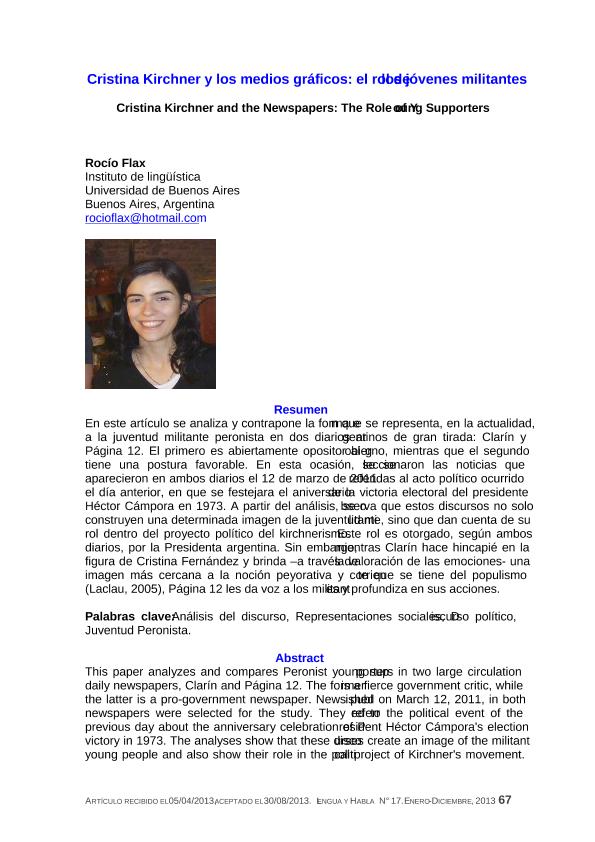Mostrar el registro sencillo del ítem
dc.contributor.author
Flax, Rocío

dc.date.available
2017-11-24T16:18:52Z
dc.date.issued
2013-12
dc.identifier.citation
Flax, Rocío; Cristina Kirchner y los medios gráficos: el rol de los jóvenes militantes; Universidad de Los Andes; Lengua y Habla; 17; 12-2013; 67-88
dc.identifier.issn
2244-811X
dc.identifier.uri
http://hdl.handle.net/11336/28995
dc.description.abstract
En este artículo se analiza y contrapone la forma en que se representa, en la actualidad, a la juventud militante peronista en dos diarios argentinos de gran tirada: Clarín y Página 12. El primero es abiertamente opositor al gobierno, mientras que el segundo tiene una postura favorable. En esta ocasión, se seleccionaron las noticias que aparecieron en ambos diarios el 12 de marzo de 2011 referidas al acto político ocurrido el día anterior, en que se festejara el aniversario de la victoria electoral del presidente Héctor Cámpora en 1973. A partir del análisis, se observa que estos discursos no solo construyen una determinada imagen de la juventud militante, sino que dan cuenta de su rol dentro del proyecto político del kirchnerismo. Este rol es otorgado, según ambos diarios, por la Presidenta argentina. Sin embargo, mientras Clarín hace hincapié en la figura de Cristina Fernández y brinda –a través de la valoración de las emociones- una imagen más cercana a la noción peyorativa y corriente que se tiene del populismo (Laclau, 2005), Página 12 les da voz a los militantes y profundiza en sus acciones.
dc.description.abstract
This paper analyzes and compares Peronist young supporters in two large circulation daily newspapers, Clarín and Página 12. The former is a fierce government critic, while the latter is a pro-government newspaper. News published on March 12, 2011, in both newspapers were selected for the study. They referred to the political event of the previous day about the anniversary celebration of President Héctor Cámpora's election victory in 1973. The analyses show that these discourses create an image of the militant young people and also show their role in the political project of Kirchner's movement. This role is conferred by the President of Argentina, according to both daily newspapers. However, while Clarín focuses on Cristina Fernández's image by giving it pejorative meaning related with the notion of populism, by means of emotion valuation (Laclau, 2005), Página 12 gives voice to militants and highlights their actions.
dc.format
application/pdf
dc.language.iso
spa
dc.publisher
Universidad de Los Andes
dc.rights
info:eu-repo/semantics/openAccess
dc.rights.uri
https://creativecommons.org/licenses/by-nc-sa/2.5/ar/
dc.subject
Análisis del Discurso
dc.subject
Discurso Político
dc.subject
Representaciones Sociales
dc.subject
Juventud Peronista
dc.subject.classification
Estudios Generales del Lenguaje

dc.subject.classification
Lengua y Literatura

dc.subject.classification
HUMANIDADES

dc.title
Cristina Kirchner y los medios gráficos: el rol de los jóvenes militantes
dc.title
Cristina Kirchner and the Newspapers: The Role of Young Supporters
dc.type
info:eu-repo/semantics/article
dc.type
info:ar-repo/semantics/artículo
dc.type
info:eu-repo/semantics/publishedVersion
dc.date.updated
2017-11-23T19:49:44Z
dc.journal.number
17
dc.journal.pagination
67-88
dc.journal.pais
Venezuela

dc.description.fil
Fil: Flax, Rocío. Universidad de Buenos Aires. Facultad de Filosofía y Letras. Instituto de Lingüística; Argentina. Consejo Nacional de Investigaciones Científicas y Técnicas; Argentina
dc.journal.title
Lengua y Habla
dc.relation.alternativeid
info:eu-repo/semantics/altIdentifier/url/http://erevistas.saber.ula.ve/index.php/lenguayhabla/article/view/4553
dc.relation.alternativeid
info:eu-repo/semantics/altIdentifier/url/https://dialnet.unirioja.es/servlet/articulo?codigo=4848387
dc.relation.alternativeid
info:eu-repo/semantics/altIdentifier/url/http://www.redalyc.org/articulo.oa?id=511951373006
Archivos asociados
